|
Monuments
and Sites of interest at Anuradhapura
205 km from Colombo is Anuradhapura, Sri Lanka's first
capital founded about the 4th century BC. According to the Mahavansa, the
Sinhala Buddhist chronicle, the city was a model of planning. Precincts
were set aside for huntsmen and scavengers and even heretics and
foreigners. There were hostels and hospitals, separate cemeteries for high
and low castes. A water supply was assured by the construction of
reservoirs.
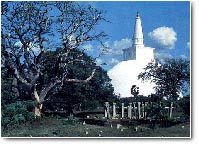 Anuradhapura was to continue for six hundred years as the national
capital. But internecine struggles for the royal succession grew, and it
became more and more vulnerable to the pressures of South Indian political
expansion. The city was finally abandoned and the capital withdrawn to
more secluded areas.
Anuradhapura was to continue for six hundred years as the national
capital. But internecine struggles for the royal succession grew, and it
became more and more vulnerable to the pressures of South Indian political
expansion. The city was finally abandoned and the capital withdrawn to
more secluded areas.
But the monuments of Anuradhapura's heyday survive, surrounded by the
solemn umbrage of trees, scions of an ancient parkland.
Brief Description
This sacred city was established around a
cutting from the "tree of enlightenment", Buddha's fig tree, brought there
in the 3rd century B.C. by Sanghamitta, the founder of an order of
Buddhist nuns. Anuradhapura, a Ceylonese political and religious capital
that flourished for 1,300 years, was abandoned after an invasion in 993.
Hidden away in thick jungle for a long time, the splendid site, with its
palaces, monasteries and monuments, is once again accessible.
World Heritage Site
Anuradhapura has been classed as a World Heritage Site by UNESCO.
The following is an extract from a research project by the Bradford University
in England. Bradford University's Department of Archaeological Sciences has found itself
linked with a number of ongoing and new collaborative research projects in
India, Pakistan and Sri Lanka. One of these projects, working in Sri Lanka,
has been working at the ancient city of Anuradhapura, which is one of UNESCO's World
Heritage Sites. In the summer of 1994 four members of Bradford University, Dr
Robin Coningham, Mr Rob Janaway, Steven Cheshire and Gary Dooney, spent six
weeks working at the site with members of the Government Department of
Archaeology and the University of Peradeniya in Sri Lanka..
Home to the royal court
Anuradhapura or 'the city of Anura', is the earliest capital of Sri Lanka and
was home to the royal court from 437 BC to 1017 AD. However it is not only a
city, but one of the great centres of Buddhism in South Asia visited by
thousands of pilgrims and tourists each year. The site consists of a central
ten metre high mound covered in jungle, marking the old urban core, surrounded
by over thirty square kilometres of Buddhist monasteries and huge reservoirs.
Amongst the most spectacular of the Buddhist monuments are four great stupas,
solid domes of earth and brick built over a Buddhist relic, which reach heights
of over eighty metres and dominate the landscape of paddy fields and coconut
trees.
New evidence
Work at this World Heritage site has been based on the research orientated
question of how and when the first recognisable urban form emerged in Sri
Lanka. According to most scholars, Anuradhapura was expected to have been
founded in c.250 BC as a direct result of contact with north Indian cities,
which themselves had emerged some two hundred years earlier in the Ganges. The
results of the research project's collaborative work have, however, overturned this belief and
show evidence of the presence of an urban form at the site as early as c.400
BC. This suggests that the mechanism which were responsible for the emergence
of cities in north India were presumably a subcontinental wide phenomena.
Indeed antecedents for the first city at Anuradhapura can now be identified in
its archaeological sequence which stretches as far back as the Iron Age.
Another task of the above-mentioned research project was to help the Government
Department of Archaeology of Sri Lanka to define the full extent of the ancient city so that
it could be adequately protected and managed. This was because there is a major
threat to the site from an encroachment of the site by modern settlements
and farming land. The group due to restraints of time and resourced limited
their research to an archaeological geophysical survey.
Through a combination of old land maps and surviving topography areas were
identified in the surrounding paddyfields where shallow linear depressions suggested
the presence of a silted moat. Areas of jungle were cleared at the edges of the
mound and set up grids which stretched down into the paddyfields and used a
resistivity meter to survey areas on the east, south and north of the mound.
This survey identified substantial anomalies which were then tested with a hand
auger. The auger confirmed that a silted
rock-cut moat some 5 metres deep and 40 metres wide surrounding the city had
been successfully identified. This
work has enabled this UNESCO World Heritage site to be protected and curated.
Royal medium
Another important area of Bradford University's research programme at Anuradhapura has
been in connection with the early
development of writing in South Asia. For over a hundred and fifty years
scholars have believed that the first script was developed c. 250 BC in the
north of the subcontinent as a result of interaction with the Persian empire.
The emergent script was first used a royal medium and then became widely
available for other uses such as helping merchants keep accounts. Following
this initial development in the north it was assumed that the use of this
script slowly spread south until it reached Sri Lanka one hundred years later.
However, the group's work at Anuradhapura has overturned this theory by yielding
evidence that the earliest script, known as Brahmi, was present in Sri Lanka
from as early as c.450 BC. Moreover, there was evidence of a developmental
sequence which saw the script alter in form from large irregular and rather
crude characters to small, well formed ones. This early date of this sequence
suggests the very development and adoption
of the script itself. All the early inscriptions were found inscribed on
ceramic vessel and consist of personal names in the dative cases - signifying
ownership. It is suggested by the researchers that the names do
not necessarily refer to the owner of the ceramic vessel but of the contents.
Ceramic vessels are often used today in Sri Lanka as containers and goods are
often transported in them. It is also suggested that the initial
adoption of a script was connected with a demand for means of ownership to
facilitate long distance trade and exchange and was only later adopted as a
royal medium.
The Bradford University's collaborative work at Anuradhapura in the summer of 1994 has helped to
preserve one of UNESCO's World Heritage sites as well as to strengthen
Bradford's academic links with South Asia.
Ruvanweli Seya Dagoba
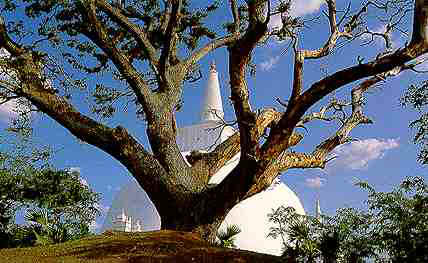
c
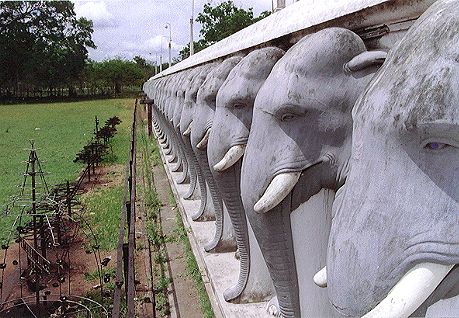
The Elephant wall of the great Ruvanweli Seya Dagoba. The
elephants carry the dagoba just like in Buddhist cosmology elephants
Some useful tips and hints to the
tourist to Anuradhapura.....
The ruins of Anuradhapura, the great capital city
from which the Sri Lankan kings reigned for over 1000 years, are spread out, so
if you don't have a car, you have the usual options of taking an expensive taxi,
hiring a bicycle or your using your two feet.
It is recommended that
you around in the Museum first. It'll give you a good insight into the history of the
place, and will show you how all those great monuments were constructed. The
museum caretaker is a very friendly and helpful guy.
The first place to go to
after the Museum, should be the Sri Maha Bodhi, the Bo tree grown from a sapling
of the original tree under which the current Buddha gained enlightenment in
India. The tree has been guarded 24 hours a day for the last 2000 years ! Also
visit the adjacent temple.
After the Bo tree, you can pretty much wander
around at will. Be sure to see the following :
- The Ruvanweli Seya Dagoba
- Considered the greatest dagoba of Anuradhapura. With its 55 meters (180
feet) in height and snowy white colour, it can be quite a hurt to the eyes in
the direct sunlight. Explore the terrace around it. You will also be impressed
by the magnificent
Elephant Wall which carries the
terrace and the dagoba.
- The Thuparama Dagoba
- The oldest dagoba of the country. It is especially noteworthy for the
splendid example of the remains of a vatadage (a mostly wooden construction
covering a dagoba).
- Jetavanarama Dagoba
- The brick Jetavanarama is a mighty sight. It is massive, and there are
enough bricks in it to build a three meter high wall, running all the way from
Edinburgh to London ! Near the dagoba the best executed Guard Stone of the
country can be seen.
- Abhayagiri Dagoba
- One of the oldest dagobas in the country, strongly resembling the
Jetavanarama.
- The Kuttam Pokuna
- Translated : the 'Twin Ponds'. The most beautiful ancient pools of
Anuradhapura, and possibly of the country.
- The Samadhi Buddha
- Don't miss the Samadhi Buddha ! It's one of the best executed Buddha
statues in the country, dating back to the 4th Century. Interesting detail is
that when looked at from the left, the Buddha appears to be smiling, but not
from the right.
- The Ratna Prasada
- There's not much left of this old monastery, but if you want to see some
more excellent guard stones, check out this place.
- Mahasen's Palace
- Here's to be found the best Moonstone of the entire country. A moonstone
is the semicircular stone that is placed on the ground at the entrance to a
temple.
- Isurumuniya
- This rock temple (and adjacent museum) is very beautiful and interesting
for the great bas-reliefs that have been found here. Most of them can be found
in the museum, the most important of them the 'Isurumuniya Lovers', but some
are still in place on the living rock, especially noticeable is the depiction
of a joyous, bathing elephant. From the top of the rock, there's a great view
of
Isurumuniya and its surroundings.
The ruins of Anuradhapura are amidst some
beautiful nature, which will make the visit very enjoyable.
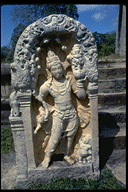 |
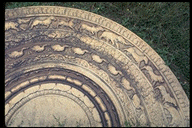 |
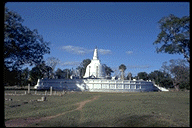 |
| Dvarapala, vihara near Thuparama dagaba |
Moonstone, vihara near Thuparama dagaba |
Thuparama dagaba |
Back to Top of Page
|





